-
Teaching sensors to think for themselves
There is a major problem with sensors: data overload; as sensors gather more and more information, it has become increasingly difficult for human users to separate out what is relevant from what is not; two U Vermont researchers received a grant from DARPA to teach sensors what to look for — and what not to look for
-
-
Safe, efficient cookstoves for earthquake survivors

316,000 people were killed and more than one million made homeless by the 12 January 2010 magnitude 7.0 quake that left the capital city of Port-au-Prince in ruins; many of the displaced Haitians still live in tent cities, where even simple tasks such as cooking are a challenge; scientists hope to find the safest and most energy-efficient way for earthquake survivors to cook
-
-
Solar UV disinfects drinking water
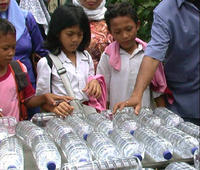
More than 800 million people around the world lack access to clean water; the water available for people to drink in many developing countries has not been treated to remove contaminants, including pathogenic microorganisms; half of the world’s hospital beds are occupied by people who are sickened by the water they drink; Purdue University researchers have invented a water-disinfection system that uses the sun’s ultraviolet radiation to inactivate waterborne pathogens
-
-
E-textiles now come with memory-storing fiber
E-textiles could help soldiers, first responders — but also the sick and infirm; the integration of electronics into textiles is a growing field of research that may soon enable smart fabrics and wearable electronics
-
-
Shells tracked by radar
With the high costs of live fire training, the Pentagon wanted a shell-scoring system, and commissioned Cambridge Consultants to develop one; after fourteen months of development, the company unveiled its holographic radar scoring system, the Land and Surface Target Scorer (LSTS)
-
-
Anti-magnet: to protect ships' hulls from mines
Researchers have created a new type of magnetic cloak which shields objects from magnetic fields — at the same time that it prevents any internal magnetic fields from leaking out; this “antimagnet” could be used to protect a ship’s hulls from mines that detonate when a magnetic field is detected
-
-
Proton-based transistor could let machines communicate with humans
Devices humans use, from light bulbs to iPods, send information using electrons; human bodies and all other living things, on the other hand, send signals and perform work using ions or protons; researchers build a novel transistor that uses protons, creating a key piece for devices that can communicate directly with living things
-
-
Future electric vehicle to run unlimited distances
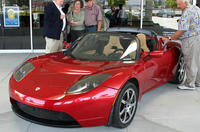
Electrically powered vehicles (EV) are promising environmentally friendly alternatives for combustion engine-based automobiles; batteries used in present-day EV, however, limit the continuous running distance from one charge; researchers propose a potentially revolutionary solution for powering EVs capable of running unlimited distances
-
-
New vest offers GPS tacking and other information
Canadian company Laipac Technology is showing its S911 GPS Vest which the company describes as “a high coverage assault protection designed for military, tactical law enforcement and VIP personnel that demand the highest protection.”
-
-
Laser device detects IEDs

Researchers have developed a laser that could detect roadside bombs — the deadliest enemy weapon U.S. and coalition soldiers encountered in Iraq and Afghanistan; the laser, which has comparable output to a simple presentation pointer, potentially has the sensitivity and selectivity to canvas large areas and detect improvised explosive devices
-
-
Man-made silk mimics spider silk
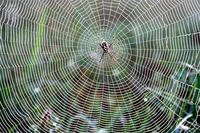
Spider silk has attracted human interest for thousands of years due to its toughness and ductility; as with most biomaterials, spider silk has evolved over millions of years resulting in a combination of properties that far exceeds any man-made material; until now
-
-
Industrial stent-like repairs for failing pipelines
There are thousands of miles of pipe underground in the United States, some more than 100 years old; gas, oil, water, and sewage seep, and sometimes gush, through corroded joints and defective welds every day; new technology uses carbon and glass laminates to repair and replace failing pipelines
-
-
Body wearable antennas for soldiers, first responders
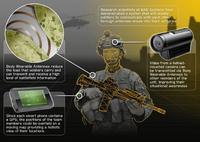
Body Wearable Antennas (BWAs) allow soldiers to communicate with their colleagues on the front line without the need for conventional radio whip-antennas which can be cumbersome and conspicuous; NWS can also be incorporate into the suits of fire-fighters for use during search and rescue, for police patrol team members to have the GPS locations of their colleagues, and in other hazardous industries such as mining, oil, and gas
-
-
Flying video camera will protect soldiers
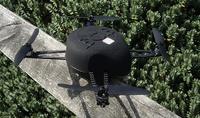
Engineers have developed the U.K.’s first lightweight outdoor flying video camera which can fit in a soldier’s backpack; the UAV is designed to help spot hidden dangers and feed the real-time footage to goggles worn by the operator
-
-
Disaster influences science fair entries
Science fair for school children in Christchurch, new Zealand see several earthquake- and flood-related inventions by junior high students; first prize went to a ninth grader who designed a possum trap to protect curious native weka from being poisoned during floods
-
More headlines
The long view
New Technology is Keeping the Skies Safe
DHS S&T Baggage, Cargo, and People Screening (BCP) Program develops state-of-the-art screening solutions to help secure airspace, communities, and borders
Factories First: Winning the Drone War Before It Starts
Wars are won by factories before they are won on the battlefield,Martin C. Feldmann writes, noting that the United States lacks the manufacturing depth for the coming drone age. Rectifying this situation “will take far more than procurement tweaks,” Feldmann writes. “It demands a national-level, wartime-scale industrial mobilization.”
How Artificial General Intelligence Could Affect the Rise and Fall of Nations
Visions for potential AGI futures: A new report from RAND aims to stimulate thinking among policymakers about possible impacts of the development of artificial general intelligence (AGI) on geopolitics and the world order.
Keeping the Lights on with Nuclear Waste: Radiochemistry Transforms Nuclear Waste into Strategic Materials
How UNLV radiochemistry is pioneering the future of energy in the Southwest by salvaging strategic materials from nuclear dumps –and making it safe.
Model Predicts Long-Term Effects of Nuclear Waste on Underground Disposal Systems
The simulations matched results from an underground lab experiment in Switzerland, suggesting modeling could be used to validate the safety of nuclear disposal sites.
